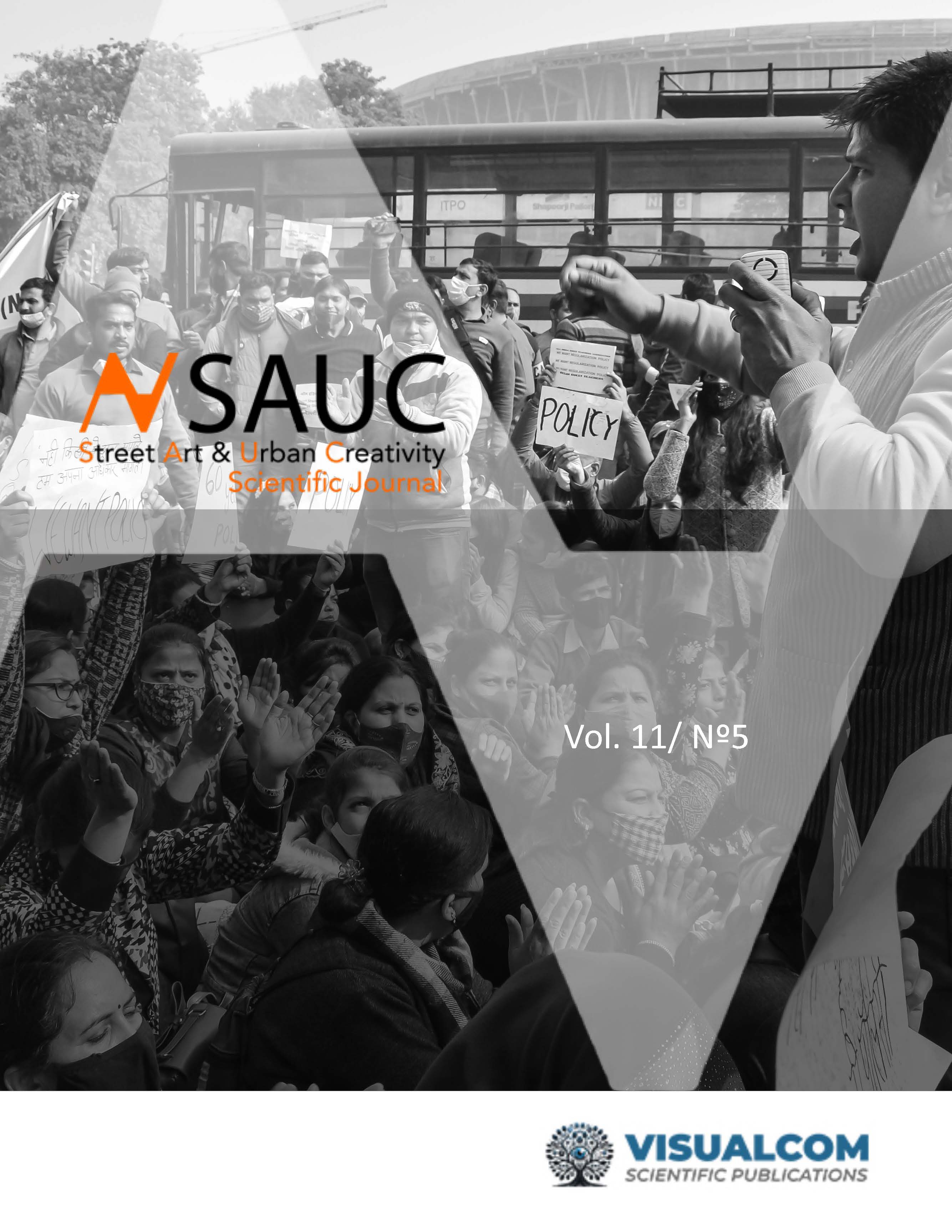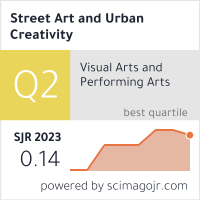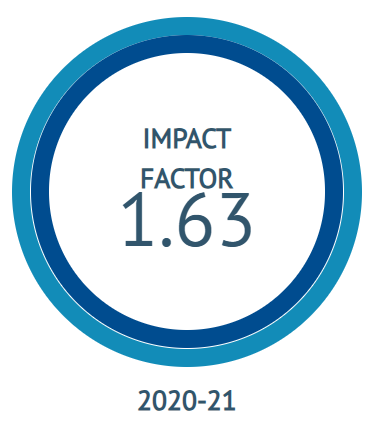Street Art: Rhetoric, Poetics, Memory and Creativity in the Transmedia Age
The rhetorical figures in the actions of Street art
DOI:
https://doi.org/10.62161/sauc.v11.5747Keywords:
Rhetoric, Poetic, Street Art, Effectiveness, Transmedia, Memorization, Urban spaceAbstract
The interrelationship between rhetoric, poetics, attention capture, creativity and memory (in the transmedia age) is examined through an analysis of the 107 street art interventions awarded either gold or special prizes between 1999 and 2024 at leading international advertising festivals. The findings are compared with the knowledge derived from the scientific documentary sources consulted. The study demonstrates the rhetorical and poetic significance not only for the conceptualisation of street art actions but also for their transmedia projection. The final contribution presents six key ideas to be considered prior to designing such interventions.
Downloads
Global Statistics ℹ️
|
241
Views
|
333
Downloads
|
|
574
Total
|
|
References
Albaladejo, C. B. (2016). Acerca de la utilidad del aula invertida o flipped classroom. En María Teresa Tortosa Ybáñez, Salvador Grau Company, José Daniel Álvarez Teruel (Ed.), XIV Jornadas de Redes de Investigación en Docencia Universitaria: investigación, innovación y enseñanza universitaria: enfoques pluridisciplinares (pp. 1466–1480). Universidad de Alicante. Instituto de Ciencias de la Educación.
Albaladejo, T. (1994). Retos actuales de la retórica. En I. P. Almansa (Ed.), Retos actuales de la Teoría Literaria (pp. 51–60). Ediciones Universidad de Valladolid.
Albaladejo, T. (2009). Retórica de la comunicación y retórica en sociedad. En B. D. Helena y Ramírez Vidal Gerardo (Ed.), Crisis de la historia, condena de la política y desafíos sociales (pp. 39–58). UNAM, Instituto de Investigaciones Filológicas. https://www.researchgate.net/publication/259691953_TAlbaladejo_Retorica_de_la_comunicacion_y_retorica_en_sociedad
Albaladejo, T. (2013). Retórica cultural, lenguaje retórico y lenguaje literario. Revista Electrónica de Estudios Filológicos, 2(2013), 1–21. http://www.tonosdigital.es/ojs/index.php/tonos/article/viewArticle/974
Alhabash, S., McAlister, A. R., Lou, C., & Hagerstrom, A. (2015). From clicks to behaviors: The mediating effect of intentions to like, share, and comment on the relationship between message evaluations and offline behavioral intentions. Journal of Interactive Advertising, 15(2), 82–96. https://doi.org/10.1080/15252019.2015.1071677
Anderson, M. y Jiang, J. (2018). Teens, social media and technology 2018. Report: Pew Research Center.
Asociación Española de Semiótica. Congreso Internacional. (1994). Semiótica y modernidad: actas del V Congreso Internacional de la Asociación Española de Semiótica, celebrado en La Coruña, 3-5 de diciembre de 1992. Universidade da Coruña, Servizo de Publicacións.
Baños Saldaña, J. Á. (2020). Metapoesía y publicidad: el poeta en la sociedad de consumo. Pasavento, 8(1), 157–176. https://doi.org/10.37536/preh.2020.8.1.690
Barthes, R. (1964). Rhétorique de lʼimage. Communications, 40–51.
Barthes, R. (1977). Image, music, text. Hill and Wang.
Barthes, R. (1986). Lo Obvio y Lo Obtuso: Imagenes, Gestos, Voces. Ediciones Paidos Iberica.
Barthes, R. (1992). Sobre Racine. Siglo XXI.
Bijmolt, T. H. A., Leeflang, P. S. H., Block, F., Eisenbeiss, M., Hardie, B. G. S., Lemmens, A., & Saffert, P. (2010). Analytics for customer engagement. Journal of Service Research, 13(3), 341–356. https://doi.org/10.1177/1094670510375603
Capriotti, P. (2006). De los media/canal a los media/público: la relación de las organizaciones con los medios de comunicación desde la perspectiva de las relaciones públicas. Hologramatica, 6(2), 19–32. https://www.cienciared.com.ar/ra/revista.php?wid=3&articulo=525&tipo=A&sid=136&NombreSeccion=Articulos&Accion=Ver
Cárdenas, D., Castaño, R., Quintanilla, C., & Ayala, E. (2022). Understanding the value of street art for artists, consumers, and brands. Journal of Current Issues & Research in Advertising, 43(2), 155–164. https://doi.org/10.1080/10641734.2022.2033652
Carrington, Y. L. (2022). The Semiotics of Graffiti. School of Communication and the Arts Regent University, 27(12), 59–77. https://doi.org/10.9790/0837-2712055977
Castells,M. (2006). La sociedad red. Una visión global. Alianza Ensayo.
Dumont González, G. A. (2021). Estudio de la transtextualidad en el cine de Quentin Tarantino. La palabra, 40, 1–21. https://doi.org/10.19053/01218530.n40.2021.12542
Frascara, J. (2002). Diseño gráfico y comunicación (7.a ed.). Infinito.
García-Jiménez, A., López-de-Ayala López, M. C., & Montes-Vozmediano, M. (2020). Características y percepciones sobre el uso de las plataformas de redes sociales y dispositivos tecnológicos por parte de los adolescentes. Zer-Revista de Estudios de Comunicación, 25(48), 269–286. https://doi.org/10.1387/zer.21556
Gago, J. M. P., Roca, J. Á. F., & Blanco, C. J. G. (Eds.). (1994). Investigaciones semióticas V: semiótica y modernidad: actas del V Congreso Internacional de la Asociación Española de Semiótica (celebrado en La Coruña, 3-5 de diciembre de 1992). Universidade da Coruña. Servicio de Publicacións.
Garrido Castellano, C., & Raposo, O. (2024). Public art and social media: street art tourism, sociocultural agency and cultural production in contemporary Lisbon. Community Development Journal, 59(3), 533–552. https://doi.org/10.1093/cdj/bsad018
Genette, G. (1974). La retórica restringida. En V. A. En (Ed.), Investigaciones Retóricas (pp. 203–222). Tiempo Contemporáneo.
Genette, G. (1982). Palimpsestes: la littérature au second degré (Éditions du Seuil, Ed.). Seuil.
Gonçalves, K., & Milani, T. M. (2022). Street art/art in the street – semiotics, politics, economy. Social Semiotics, 32(4), 425–443. https://doi.org/10.1080/10350330.2022.2114724
Greenwald, A., & Leavitt, C. (1984). «An audience involvement in advertising: Four levels. Journal of Consumer Research, 11, 581–592.
Homer, P. M., & Kahle, L. R. (1986). A social adaptation explanation of the effects of surrealism on advertising. Journal of advertising, 15(2), 50–60. https://doi.org/10.1080/00913367.1986.10673005
Jenkins, H., Ford, S., & Green, J. (2013). Spreadable media: Creating value and meaning in a networked culture. NYU Press.
Kahle, L. R., Kambara, K. M., & Rose, G. M. (1996). A Functional Model of Fan Attendance Motivations for College Football. Sport Marketing Quart erly, 5, 51–60.
Kearney, M. C. (2004). Recycling Judy and Corliss: Transmedia exploitation and the first teen-girl production trend. Feminist Media Studies, 4, 265–295.
Keyelaar, P. E., & Van Gisbergen, M. S. (2006). Openness in advertising. Occurrence and effects of open advertisements in magazines. https://hdl.handle.net/2066/55781
Lagos Caamaño, J. (2010). Retórica de la imagen en Anteparaíso de Raúl Zurita. Estudios Filológicos, 45. https://doi.org/10.4067/s0071-17132010000100004
Leigh, J. (1994). «The use of figures of rhetoric in print ad headlines. Journal of Advertising, 23, 17–34.
Magariños De Morentin, J. A. (1983). El mensaje publicitario (1a). Hachette.
Marín, G. J., & Abeja, D. G. (2006). El uso de la pintura en la publicidad de revistas femeninas en España. Análisis de la publicidad que usa pintura en la revista “Vogue”. Tripodos, Extra, 245–257. http://hdl.handle.net/11441/29076
Martínez Sáez, J. & Palao, J. A. (2009). El cine y el entorno visual. Material docente Módulo La innovación en la obra audiovisual. Valencia Internacional University.
Martínez Sáez, J., Canós Cerdá, E., & Sanchis Roca, G. (2017). Narrativas transmedia y publicidad: análisis de las campañas más premiadas (2011-2016). adComunica: Revista científica de estrategias, tendencias e innovación en Comunicación, 14, 51–74. https://doi.org/10.6035/2174-0992.2017.14.4
McClinchey, K.A. (2023). Street art and creative place-making: urban tourism regeneration in Toronto, Canada. International Journal of Tourism Cities, 10(1), 129-145. https://doi.org/10.1108/IJTC-05-2022-0146
Mcquarrie, E., & Mick, D. (1993). «Reflections on classical rhetoric and the inci dence of figures of speech in contemporary magazines advertisements. Advances in Consumer Research, 20, 309–313.
Meyers-Levy, J., & Malaviya, P. (1999). Consumers’ processing of persuasive advertising. An integrative framework of persuasion theories. Journal of Marketing, 63, 45–60.
Moliné, M. (2000). La fuerza de la publicidad. En Saber hacer Buena publicidad, saber administrar Su fuerza. McGraw-Hill Companies.
Mondino, M. (2014). Street art, spaces and visual rhetoric. Between, 4(7). https://doi.org/10.13125/2039-6597/1133
Montenegro Hidalgo, V. (2021). Los procesos comunicativos sincrónicos y asincrónicos, una experiencia de educación superior: Synchronic and asynchronic communicative Processes. A case study of higher education in Pandemic. TSAFIQUI Revista Científica En Ciencias Sociales, 12,1. https://doi.org/10.29019/tsafiqui.v12i17.965
Mostafa, M. (2005). An experimental investigation of the Egyptian consumenrs’ attitudes towards surrealism in advertising. International Journal of Consumer Studies, 3, 216–231. https://doi.org/10.1111/j.1470-6431.2005.00406.x
Ndubuisi, B. J. (2019). Advertising Practice in Nigeria: development, new trends, challenges and prospects. African Journals Online, 47-54. https://doi.org/10.4314/EJOTMAS.V3I1-2
Odiboh, OO. (2022). Integrated marketing communication. Lagos: APCON
Olarte, E.G., Panizzi, M.D., & Bertone, R.A. (2018). Segmentación de Mercado Usando Técnicas de Minería de Datos en Redes Sociales. Universidad Nacional de La Plata. Tandil, 471-480 https://sedici.unlp.edu.ar/handle/10915/73226
Ortiz, M. J. (1970). Teoría integrada de la metáfora visual. Communication & Society, 23(2), 97-124. https://doi.org/10.15581/003.23.36238
Pascual, S. F. (2016). Propuesta de un modelo de comunicación para la realización de una acción de Street Marketing-Street Art. Universidad de Alicante. http://hdl.handle.net/10045/56210
Pastor Ruiz, Y., Martín Nieto, R., & Montes Vozmediano, M. (2019). Patrones de uso, control parental y acceso a la información de los adolescentes en la red. Estudios sobre el mensaje periodístico, 25(2), 995–1012. https://doi.org/10.5209/esmp.64821
Perelman, C. (1958). La nueva retórica. Madrid. Gredos, 1989.
Pérez, M. C. (2008). La recepción de las figuras retóricas de textos publicitarios: una experiencia orientada a la enseñanza / aprendizaje del alumnado de traducción. Quaderns: Revista de traducció, 15, 169–186.
Phillips, B. J. (2000). The impact of verbal anchoring on consumer response to image ads. Journal of advertising, 29(1), 15–24. https://doi.org/10.1080/00913367.2000.10673600
Racionero, Q. (2022). Retórica. Editorial Gredos.
Ramos, M. (2006). Cuando la marca ofrece entretenimiento: aproximación al concepto de advertainment. Questiones publicitarias, 11, 33–49. https://doi.org/10.5565/rev/qp.134
Ramos-Galarza, C. A. (2020). Alcances de una investigación. CienciAmérica, 9(3), 1-6. https://doi.org/10.33210/ca.v9i3.336
Raposo, O. R. (2023). Street art commodification and (an)aesthetic policies on the outskirts of Lisbon. Journal of Contemporary Ethnography, 52(2), 163–191. https://doi.org/10.1177/08912416221079863
Rodríguez Fidalgo, Mª Isabel; Paíno Ambrosio, Adriana; Ruiz Paz, Yanira y Jiménez Iglesias, Lucía (2017). Cambios en los modelos persuasivos: la nueva publicidad en tiempo real a través de estrategias narrativas transmedia. Estudio de caso de la campaña publicitaria de Tous, Tender Stories En: adComunica. Revista Científica de Estrategias, Tendencias e Innovación en Comunicación, 14., 27-50. http://dx.doi.org/10.6035/2174-0992. 2017.14.3
Rodríguez, O. A. P. (2021). La teoría fundamentada: origen, supuestos y perspectivas. Intersticios Sociales, 22. https://doi.org/10.55555/is.22.332
Rossiter, J. R., Langner, T. & Ang, L. (2003). Visual creativity in advertising: a functional typology. In R. Kennedy (Eds.), Proceedings of the Australian and New Zealand Marketing Academy Conference (pp. 105-113). Adelaide, Australia: Australian and New Zealand Marketing Academy.
Ruder, E. (1983). Manual de Diseño Tipográfico. Gili.
Simões, A.V. (2023). Street Art in Aveiro: City Walls as Dialogic Spaces of Collective Memories and Identity. Societies, 13, 54. https:// doi.org/10.3390/soc13030054
Toffler, A. (1980). The third wave. William Morrow and company.
Vale, L., & Fernandes, T. (2018). Social media and sports: driving fan engagement with football clubs on Facebook. Journal of Strategic Marketing, 26(1), 37–55. https://doi.org/10.1080/0965254x.2017.1359655
Vanderwood, P. J., & Chaffee, L. G. (1994). Political protest and street art: Popular tools for democratization in Hispanic countries. The Hispanic American historical review, 74(4), 695. https://doi.org/10.2307/2517499
Vargas, L., Mensa, M., & González, E. (2014). El uso de figuras retóricas en anuncios publicitarios y pinturas de Magritte: análisis sobre su efecto en la rememoración de marca en el corto plazo. Arte individuo y sociedad, 26(1). https://doi.org/10.5209/rev_aris.2014.v26.n1.41079
Viro, Á. C. (2016). Flores del árbol de la publicidadLa poesía publicitaria en España. Interférences littéraires/Literaire interferenties, 18, 31–49. https://interferenceslitteraires.be/index.php/illi/article/view/171/120
Vitalis, P. O., Onyejelem, T. E., & Okuneye, A. P. (2024). Understanding advertising in the era of social media. Information System and Smart City, 3(1), 502. https://doi.org/10.59400/issc.v3i1.502
VVAA (2011). Tratado del signo visual: Para una retórica de la imagen. Ediciones Cátedra.
VVAA (2018). Técnicas y métodos cualitativos para la investigación científica. Editorial UTMACH.
Zhang, J., Yang, X., & Peracchio, L. (2009). The persuasiveness of stylistic properties: the moderating role of ideal-self vs. ought-self. Advances in Consumer Research, 36, 715–735.
Zorita Arroyo, D. (2022). Poesía y publicidad en tres poetas de la España tardofranquista. Anales de Literatura Española, 37, 167–191. https://doi.org/10.14198/ALEUA.2022.37.08
Downloads
Published
How to Cite
Issue
Section
License
Copyright (c) 2025 Authors retain copyright and transfer to the journal the right of first publication and publishing rights

This work is licensed under a Creative Commons Attribution-NoDerivatives 4.0 International License.
Those authors who publish in this journal accept the following terms:
-
Authors retain copyright.
-
Authors transfer to the journal the right of first publication. The journal also owns the publishing rights.
-
All published contents are governed by an Attribution-NoDerivatives 4.0 International License.
Access the informative version and legal text of the license. By virtue of this, third parties are allowed to use what is published as long as they mention the authorship of the work and the first publication in this journal. If you transform the material, you may not distribute the modified work. -
Authors may make other independent and additional contractual arrangements for non-exclusive distribution of the version of the article published in this journal (e.g., inclusion in an institutional repository or publication in a book) as long as they clearly indicate that the work was first published in this journal.
- Authors are allowed and recommended to publish their work on the Internet (for example on institutional and personal websites), following the publication of, and referencing the journal, as this could lead to constructive exchanges and a more extensive and quick circulation of published works (see The Effect of Open Access).













